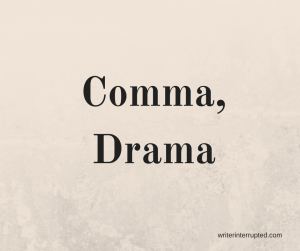
Punctuation, blech! Yes, I know, but it’s not as bad as grammar—a subject we’ll tackle another time. In my craft blog today, I’ll share a few simple comma guidelines. And I do mean simple! Okay, now that you’re wiping the sweat from your brow, let’s go.
Introducing: The Comma
That little flip on the page causes many of us to flip out! So when do we use the teensy tittle and when not?
Parenthetical Phrase – A parenthetical phrase is a set of words inserted into a sentence that modifies the meaning of the sentence, but if the phrase were removed, the sentence would still be complete. I use a parenthetical phrase in my first paragraph in the sentence that begins with “In my craft blog.” Since the parenthetical phrase is placed at the beginning of the sentence, I need a comma. If I had placed the parenthetical phrase at the end of the sentence, I would not need a comma. The sentence would read, “I’ll share a few simple punctuation guidelines in my craft blog today.” See? I didn’t lie. That was easy.
Exception: If your parenthetical phrase on the end of a sentence begins with an “ing” word, you do need a comma. Example: The man staggered away, sputtering in a foreign language. Again, pretty simple rule of thumb.
Compound vs. Simple Sentences – I see this error all the time, but a quick question can clear it up. Does the sentence contain two sets of words that could make complete sentences on their own (these are called independent clauses), and are these complete sentences connected by the use of a conjunction such as and, or, but, yet, so, etc? If the answer is yes to both halves of this question, you need a comma. If the answer is no, slap your hand away from that comma key. Please note that the question above is an example of a compound sentence.
Exception: This would be at your publishing company’s discretion, but some houses will omit the comma if the compound sentence is very short. For instance: I went, but he stayed. The comma is correct here, but some publishers may take it out. My suggestion is go with what’s technically right and let the editor fix what she doesn’t like.
Which or That – When writing a sentence that includes a phrase beginning with “which” or “that,” use a comma before “which,” but no comma before “that.” Example: I took the book, which was on the counter. I took the book that was on the counter.
Here’s a little free side-tip: Please note that there is a subtle difference of meaning in these two sentences brought about by the choice to use “that” or “which.” The first sentence indicates that the speaker was looking for a specific book and found it on the counter. The second sentence, the one that uses “that,” implies that the speaker took a book from the counter, but didn’t necessarily care what book it was. She just took whichever one was on the counter. So when deciding between “that” or “which,” keep in mind that you will be conveying a different meaning with each word.
The nuances of the comma are far from exhausted by these simple tips, but fixing these areas will go a long way toward making your manuscript look and read more professional.
